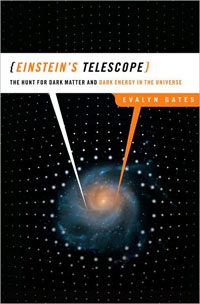Review: Einstein’s Telescopeby Jeff Foust
|
| f things like WIMPs and dark matter (or its even more mysterious acquaintance, dark energy) leave your scratching your head, a good place to turn is Evalyn Gates’ new book, Einstein’s Telescope. |
The common thread running through much of the book, and from which the title comes from, is one of the key tools in helping study an increasingly bizarre universe. When Albert Einstein was developing general relativity, he noted that the warping of spacetime created by massive objects like stars could serve as a lens, resulting in unusual optical effects. He fleshed out those ideas years later in a journal article, but dismissed the idea of gravitational lensing as a theoretical curiosity with “no hope of observing this phenomenon directly.” Decades later, Einstein’s dismissal of lensing was proven wrong, thanks to advances in telescopes and instruments that made it possible to observe lensing as well as an interest in using the tool to understand the composition of the universe.
Gravitational lensing has become one tool in the search for dark matter, whose presence is inferred from the rotational curves of the Milky Way and other galaxies: these measures of rotational velocity as a function of distance from a galaxy’s center can only be explained if galaxies are embedded in much larger haloes of unobserved “dark” matter that are many times more massive that the observed galaxies themselves. Gravitational lensing has been used to search for one candidate for that dark matter, called massive compact halo objects, or MACHOs: objects of ordinary matter, ranging from Jupiter-sized objects to black holes, that elude normal detection, but which could be found when they served as a gravitational lens, briefly brightening more distant objects. Gravitational “microlensing” observations, carried out over several years, did detect some MACHOs, but not in the quantity needed to explain dark matter. (Gravitational microlensing may have struck out in the search for dark matter, but as the book notes, it’s become a useful tool in other areas of research, including the search for extrasolar planets.)
Einstein’s Telescope goes on to review the current state of knowledge of dark matter as well as dark energy, the mysterious force that comprises nearly three-fourths of the universe and is responsible for accelerating the expansion of the universe, as determined by observations of supernovae. Here dark matter and gravitational lensing cross paths again, this time with the web of dark matter pervading the universe serving as the lens itself, allowing astronomers to study the structure and evolution of that web, which is influenced by dark energy. It may take years before these and other efforts bear any fruit in the quest for understanding the universe, but for now those confused by concepts like dark matter and dark energy can read this book to get a better grasp on these topics—and understand why astronomers can be just as puzzled.
